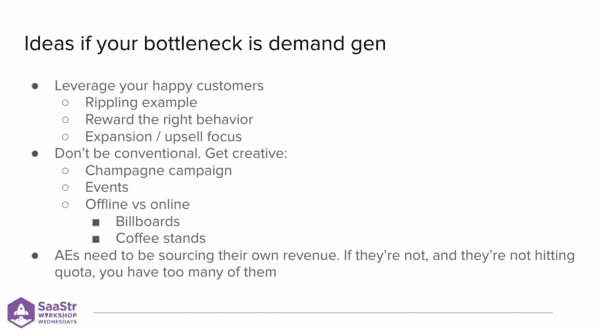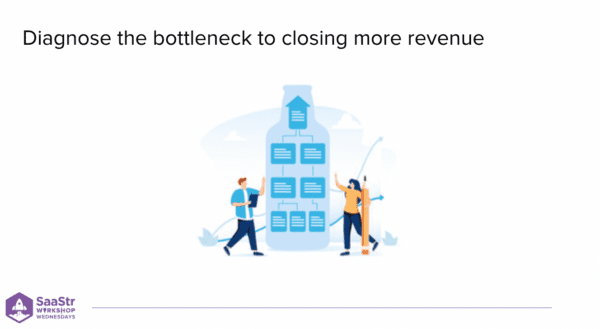2023 has been a difficult year for many tech companies. Markets have been all over the place, layoffs occurred, and investors weren’t funding as much as usual. However, Sam Blond, Partner at Founders Fund & Host of the SaaStr CRO Confidential Podcast, believes there are reasons to be optimistic for the rest of 2023.
In a special workshop, Sam shares advice on how to spot bottlenecks, reallocate the right resources, and grow revenue in 2023.
SaaStr Workshop Wednesdays are LIVE every Wednesday. Sign up for free.
Step One: Run Your Numbers
It may seem basic, but start by reviewing your numbers, especially those associated with your GTM strategy or GTM funnel. Ensure you take into account things like:
- How many qualified opps are you creating per month?
- How many qualified opps are there per sales rep?
- What do conversion rates look like? How are they trending over time?
- Do you have an implementation backlog?
- How long is the onboarding cycle for a new customer?
Even if you are just starting out, it’s vital to start tracking these things as soon as possible. “You want to have a baseline understanding of how the business is performing at a very early stage.”

Step Two: Diagnose the Bottleneck to Closing More Revenue
When your company doesn’t hit target revenue, it can be tempting to zero in on conversion rates. But this is not necessarily the cause of the missed target. Blond says, “The bottleneck in four out of five companies that I speak with is opportunity creation. It’s demand-gen. This is often misdiagnosed as conversion rates.” It’s important to properly diagnose where the hold-up is instead of getting fixated on the wrong part of the funnel.
Blond explains that he’s spoken with executives who focus on big deals falling through to explain stagnating growth. While lost deals have an impact, the real revenue bottleneck may lay elsewhere in the buyer journey.
One way to get a clear insight into your demand gen environment is to examine the number of opps created per AE and then pull up sales reps calendars. Note that no one-size-fits-all number works for every business since sales cycles can look completely different depending on the product and the target market. For example, consider how different an enterprise sales cycle looks compared to a small business sales cycle.
But for many companies, a good range is around two new demos per day on every sales rep’s calendar. After assessing the calendars and opps created, you’ll get a clearer picture of what’s actually going on in your funnel. If you see that the sales reps are swimming in demand and that the bottleneck lies elsewhere, you go down the funnel to see where to focus efforts. Are the leads converting? If they aren’t, why not? Is it demo quality? PMF issues? Do you need sales training? Could reps be poorly educated on the product itself? Is onboarding or implementation taking too long?
The fix will depend on the bottleneck, so it is crucial to identify the sticking point blocking growth.
Step Three: Map Your GTM to Your Acquisition Funnel
The next thing to think about is how the go-to-market organization maps to the customer acquisition funnel. In other words, how many people do you have dedicated to generating demand? Are the AEs outbounding? If they are, what percentage of your closed revenue do you attribute to AE outbound?
Blond emphasizes, “We’re trying to map the existing resources both by persona and then also by activity to the acquisition funnel. And we can see where people and focus is concentrated.”
Step Four: Rightsize and Refocus the GTM Org Based on the Bottleneck
Once you have mapped your funnel and resources, you can reassess the org and refocus efforts where the bottleneck occurs.
So, for instance, if you have AEs who are outbounding but aren’t generating a lot of closed revenue, then your bottleneck is demand gen. If most of your resources are focused toward the end of the funnel, you may have to reallocate resources.
If you have AEs who passively wait for demos to fall in their laps, that must change. The way to fix this is either by shrinking the AE team or having them focus on demand-gen and acquiring their own customers. However, making the shift can be difficult. And it is especially challenging for larger companies. Blond elaborates, “This culture of outbound where AEs generate their own demand and ultimately source their own revenue; it becomes ingrained in the culture, and I have seen companies really struggle with making this shift. So if you have a mature sales organization that historically has not done much outbound and has not generated much demand and revenue on their own, it’s hard to change that.”
If your company has difficulty transitioning in a case like this, consider shifting resources around or cutting down team size. “More salespeople does not mean more sales,” Blond says.
Ideas If Your Bottleneck is Demand Gen
If your revenue block does stem from your demand gen efforts, there are a few ways to counter-act this issue.
- Leverage your happy customers. Reward your customers for their advocacy and evangelism. Consider thanking customers who spread the word about your product, and create a reward system or a referral program. Dedicating resources to expansion and upsell revenue is also a good idea.
- Don’t be conventional. Get creative. Your outbound doesn’t have to look like everyone else’s. Think about getting your target market’s attention with innovative, out-of-the-box ideas. Find ways to stand out with things like creative direct mail campaigns, event sponsorships, and offline tactics.
- Make AEs part of demand gen. AEs need to be sourcing their own revenue. If they’re not, and they’re not hitting quota, you have too many of them.

Key Takeaways
- Make sure you understand your GTM performance metrics.
- Diagnose your biggest constraint to faster growth.
- Map your existing team to your customer acquisition funnel.
- Make sure your GTM resources are appropriately mapped to your biggest bottleneck.
- More salespeople ≠ More Sales


